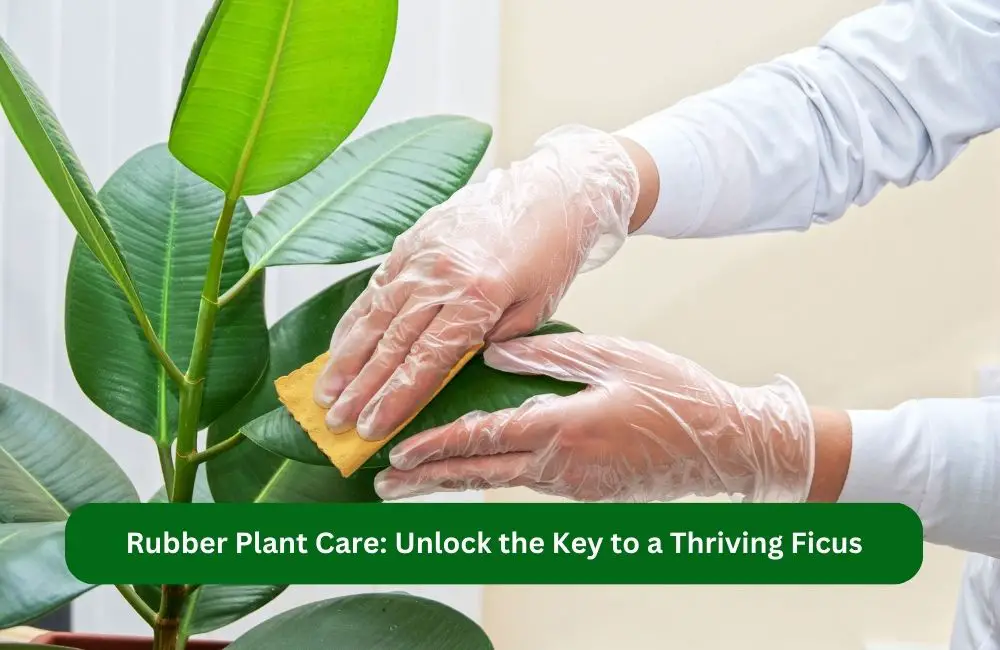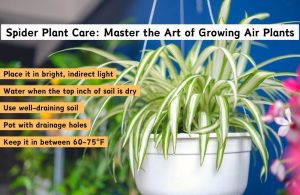This article covers the following areas –
- The Basics of Rubber Plant Care
- Those Little Extra Touches
- Common Rubber Plant Troubles and Quick Fixes
- Final Words
- FAQ: Rubber Plant Care
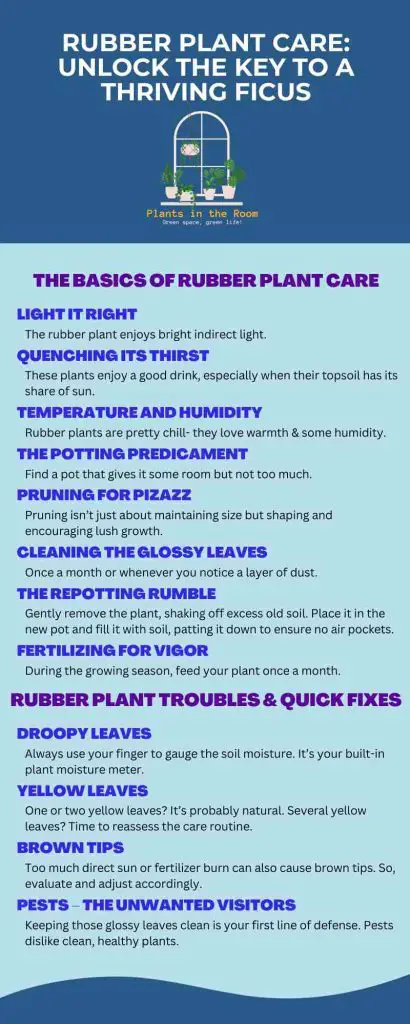
If you’ve recently found yourself the proud parent of a Ficus elastica, better known as the rubber plant, congratulations! These glossy-leaved beauties can grow to impressive heights and be a stunning addition to any living space. And if you’re reading this, it’s probably because you want to give your new green buddy the best care possible. I’m here to help you do just that.
A rubber plant or Ficus elastic requires bright, indirect light, well-draining soil, and moderate watering. Ensure a temperature range of 60-75°F (15-24°C) and maintain humidity. Regularly prune for growth, clean its leaves, and repot as needed.
Continue reading for a deeper dive into each aspect of rubber plant care, including troubleshooting common issues and understanding its nuanced needs. I cover everything from lighting specifics to decoding leaf messages.
The Basics of Rubber Plant Care

So, you’ve brought home this glossy-leaved gem, the rubber plant. Or maybe you’ve been glancing at a corner of your room, picturing where it would fit perfectly. Either way, this is where your green-thumbed journey starts.
The rubber plant, known scientifically as Ficus elastica, is a stunner for its beauty, resilience, and adaptability. But just like any houseplant, its care regimen has a sweet spot. From the luminance it soaks in, to the hydration it sips, and the atmospheric vibes it thrives in.
Light It Right
Ah, sunlight – the breakfast, lunch, and dinner for our green pals. The rubber plant enjoys bright, indirect light. Imagine it as the person at the beach basking under an umbrella rather than in the direct sun. They’re not too fond of direct sunlight as it can give them a leafy sunburn, or as we call it, “scorch their leaves.”
But, there’s a sign they’ll show if they aren’t getting enough: stretching leaves. If you notice its leaves elongating unnaturally towards the light or becoming a tad pale, it’s like the plant’s way of saying, “More sunshine, please!” Adjust its position accordingly, maybe a bit closer to the window, but still shielded from direct rays.
Quenching Its Thirst
Watering – a plant parent’s most pondered puzzle. The rubber plant’s watering mantra is simple: Keep it regular, but don’t drown it. These plants enjoy a good drink, especially when their topsoil has its share of sun. However, they’re a tad claustrophobic; they don’t like wet feet or, in simpler terms, sitting in water. Here’s a quick guide:
- Choose a pot with drainage holes.
- Use well-draining soil. Think of it as the fluffy towel of the plant world.
- Watering cue: Poke your finger in. If the top inch of the soil feels dry, it’s time for a drink. If it feels damp, hold off a bit.
- Post-watering: Ensure the excess drains out. If your plant sits in a saucer, empty that saucer if water collects.
Temperature and Humidity: Getting it Just Right
Plants, much like us, have their favorite temperature spots. For the rubber plant, think tropical vibes without the intense heat. Rubber plants are pretty chill – they love warmth and some humidity. But don’t sweat (pun intended); they’re also surprisingly resilient.
- Ideal temperature: A room with 60-75°F (15-24°C) makes them happy. But a little dip to 50°F (10°C) occasionally? They won’t hold a grudge.
- Humidity hero: If your home air feels like the Sahara, give your Ficus a break. Consider placing a humidifier nearby. No humidifier? No worries. Misting works wonders. A little spray here and there, and you’re golden.
The Potting Predicament
Sometimes, the pot makes all the difference. Here’s a brief breakdown:
- Size Matters: Your rubber plant doesn’t want to swim in soil but doesn’t want to be squished. Find a pot that gives it some room but not too much.
- Material Magic: Terracotta? Ceramic? Plastic? Each has its pros and cons. Terracotta is breathable but dries out faster. Ceramic is balanced. Plastic holds moisture, but ensure it has drainage holes.
- Drainage is Key: We’ve mentioned it before, but it’s worth repeating. Those drainage holes are your rubber plant’s lifeline. Ensure they’re clear and working.
Armed with these basics, you’re well on your way to being the talk of the plant parent community – or, at the very least, having a thriving rubber plant that becomes the envy of your guests!
Those Little Extra Touches
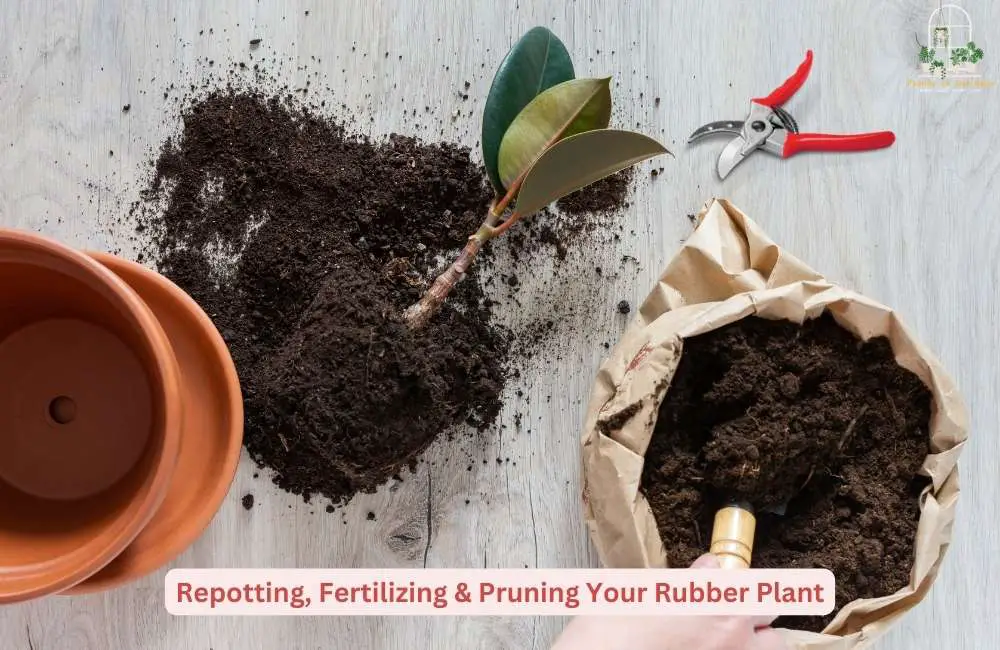
We’ve mastered the basics. The right light, the perfect sip of water, and the ideal room vibe. But for those looking to elevate their rubber plant game – to make that Ficus survive and truly thrive – it’s all about those little extra touches.
Think of it as the difference between throwing on an outfit and accessorizing it just right. It’s about getting that Insta-worthy Ficus, which gets all the “oohs” and “aahs.” Let’s delve into the tender loving care that takes your rubber plant from “doing okay” to “absolutely dazzling.”
Pruning for Pizazz
Before you snip-snap on your plant, remember: it’s a combined art and science. Pruning isn’t just about maintaining size but shaping and encouraging lush growth. Here’s a guide to doing it right:
- Why prune? To shape, to remove damaged leaves, and to encourage branching. Plus, a well-pruned rubber plant is a happy, bushy rubber plant.
- The Technique: Always cut just above a leaf node (that tiny bump or nub where leaves spring from). This encourages new growth right from that spot.
- Tools: Use sharp, clean scissors or pruning shears. The cleaner the cut, the better it is for the plant.
- Timing is Everything: Ideally, prune during the growing season – usually spring or early summer.
Cleaning the Glossy Leaves
Think of this as a spa day for your rubber plant. Those broad, glossy leaves are not just for show; they’re working hard, breathing in carbon dioxide and breathing out oxygen. But sometimes, they get a little dusty. And a dusty leaf is a sad, suffocated leaf. Here’s how to pamper them:
- Why clean? Clean leaves can photosynthesize better. It’s also a great way to check for pests.
- The Technique: Use a soft cloth dipped in lukewarm water. Gently wipe the surface of each leaf. You can use a touch of natural leaf shine or even a smidgeon of milk for an added shine.
- Frequency: Once a month or whenever you notice a layer of dust. It’s therapeutic for you and the plant.
The Repotting Rumble
If you hear your Ficus whispering, “I need more space!” it’s probably time to repot. Here’s the lowdown:
- Signs Your Plant is Ready: Roots peeking out from the drainage holes, the soil drying out super fast, or the plant simply looking too big for its pot.
- The Perfect Pot: Choose one that’s 1-2 inches larger in diameter than the current one. Remember, drainage holes are non-negotiable!
- The Soil Situation: Fresh soil gives your plant a nutrient boost. Opt for a mix designed for indoor plants with good drainage properties.
- Steps: Gently remove the plant, shaking off excess old soil. Place it in the new pot and fill it with soil, patting it down to ensure no air pockets.
Fertilizing for Vigor
Just like us, plants need a little dietary supplement occasionally.
- Why fertilize? Over time, even with repotting, your plant will exhaust the nutrients in its soil. Fertilizing gives it that extra boost.
- The Mix: A balanced liquid fertilizer (think 10-10-10) diluted to half strength is generally great for rubber plants.
- Frequency: During the growing season, feed your plant once a month. In the dormant winter months, let it rest.
With these extra touches, your Ficus elastica will flourish and not just live. And trust me, there’s no better feeling than seeing your plant buddy lush, vibrant, and thriving under your care.
Common Rubber Plant Troubles and Quick Fixes
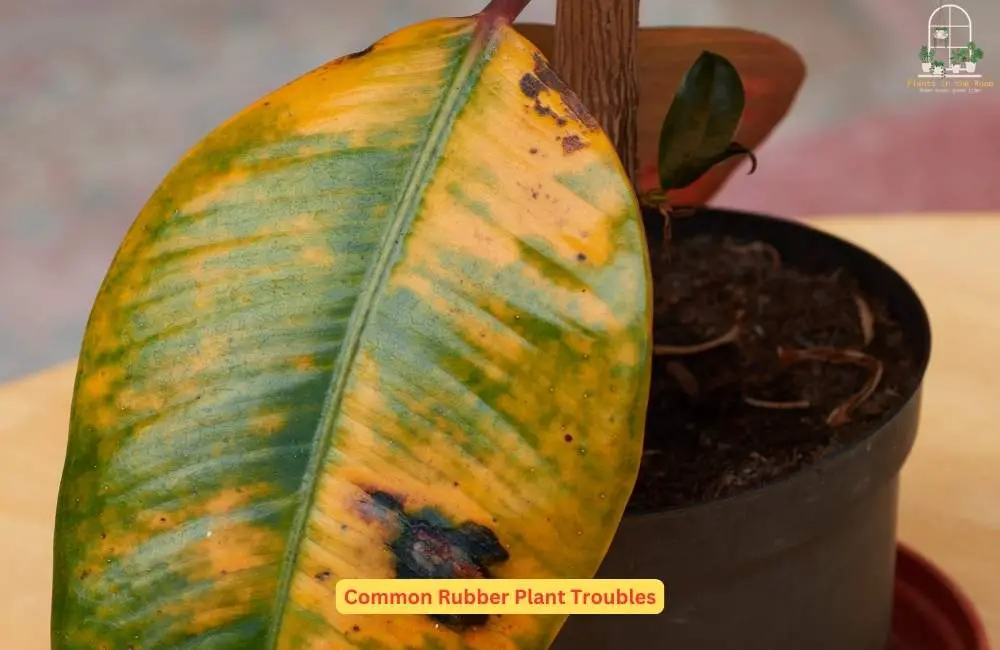
Okay, let’s get real for a moment. No matter how green their thumb is, every plant parent has faced a plant hiccup or two. I know I’ve had my “uh-oh” moments, staring at a leaf and wondering, “Why are you drooping like that?” or “Did I do something wrong?” It happens! Rubber plants, as resilient as they are, might occasionally throw some curveballs your way.
But, as always, I’ve got your back. Let’s decipher these plant SOS signals and, more importantly, understand how to set things right. Think of this as a troubleshooting manual for your lush, green buddy. Ready to play plant doctor?
Droopy Leaves
Ah, the age-old droop conundrum. It’s like your plant’s way of throwing a little fit. But don’t fret, here’s the deal:
- Over-watering: You’ve been too generous if the soil feels like a marshland. Let the top inch dry out before the next watering. Remember, moderation is key.
- Under-watering: Crumbly, dry soil? Oops! Time to hydrate. But again, no flooding, just a good soak.
- Quick Tip: Always use your finger to gauge the soil moisture. It’s your built-in plant moisture meter.
Yellow Leaves
Seeing a rubber plant leaf turn yellow is a bit like spotting that first gray hair. Sometimes, it’s natural; sometimes, it’s stress. Here’s the scoop:
- Natural Aging: Older leaves at the bottom might turn yellow and drop off as the plant matures. It’s the circle of life.
- Over-watering: Yes, over-watering is a serial offender. Yellow, mushy leaves? Cut back on water.
- Insufficient Light: Too much shade can also cause leaves to turn yellow. Maybe your Ficus is hinting at a slight relocation?
- Quick Tip: One or two yellow leaves? It’s probably natural. Several yellow leaves? Time to reassess the care routine.
Brown Tips
The dreaded brown tips – it’s like your plant’s silent cry for humidity. Let’s tackle this:
- Low Humidity: Remember, these are tropical plants. They fancy a bit of moisture in the air. Low humidity can cause those crispy brown tips.
- The Fix: Get that humidifier running or embrace the age-old misting technique. Remember, it’s like giving your plant a gentle rainforest shower.
- Other Causes: Too much direct sun or fertilizer burn can also cause brown tips. So, evaluate and adjust accordingly.
Pests – The Unwanted Visitors
Like every popular person has a few hangers-on, popular plants can attract pests.
- Common Culprits: Watch out for spider mites, scale, and aphids. They love the juicy rubber plant.
- The Defense: A soapy water spray can work wonders. If the infestation is bad, consider organic insecticidal soap or neem oil.
- Prevention: Keeping those glossy leaves clean is your first line of defense. Pests dislike clean, healthy plants.
There you have it, the A to Z of rubber plant SOS signals. With some observation, intuition, and these tips in your toolkit, you’ll navigate the plant parent journey like a pro. Remember, it’s all about balance and listening to what your green buddy tells you. Every leaf, droop, or color change is a conversation. So, stay attentive, stay loving, and keep growing!
Final Words
Caring for a rubber plant combines science and art like any botanical endeavor. Armed with the basics and a dash of intuition, you’re well on your way to fostering a thriving Ficus elastica. This resilient yet elegant plant enhances indoor aesthetics and offers a rewarding growth experience – both for the plant and the caregiver.
Whether you’re troubleshooting a leaf issue, giving it a spa day, or simply enjoying its vibrant presence, remember: it’s a journey. Every day with your rubber plant offers a lesson in patience, observation, and the simple joys of nurturing life. Embrace the ride, celebrate the small victories, and cherish the green bond.
FAQ: Rubber Plant Care
1. What is a Rubber Plant?
The Rubber Plant, scientifically known as Ficus elastica, is a popular houseplant renowned for its glossy, dark green leaves. It’s part of the Ficus genus and is loved for its impressive growth and aesthetic appeal.
2. How much sunlight does a Rubber Plant require?
Rubber Plants thrive in bright, indirect sunlight. However, they can tolerate some direct morning sunlight. Too much direct sun can lead to scorched leaves, so monitoring their exposure is essential.
3. How frequently should I water my Rubber Plant?
Water the Rubber Plant when the soil’s top 1-2 inches feels dry. It’s crucial to avoid over-watering, which can cause root rot. The plant prefers consistent moisture without becoming waterlogged.
4. Why are the leaves on my Rubber Plant dropping?
Leaf drops can occur for several reasons, including over-watering, low humidity, or sudden temperature changes. Ensure the plant has a stable environment, and adjust your watering routine if necessary.
5. Can I prune my Rubber Plant?
Yes, Rubber Plants can be pruned to control their size and shape. Regular pruning can also promote more branching and a bushier appearance.
6. Is the Rubber Plant toxic to pets and humans?
Yes, the Rubber Plant contains a milky sap that can be irritating if ingested. Keeping the plant out of reach of pets and children is advisable.
7. How can I propagate my Rubber Plant?
Rubber Plants can be propagated through stem cuttings. Cut a healthy stem segment, let it dry for a few hours to form a callus, then plant it in well-draining soil. With proper care, it should root in a few weeks.
8. What’s the best soil mix for Rubber Plants?
A well-draining potting mix is ideal for Rubber Plants. You can use a mix of standard potting soil with perlite or orchid bark to ensure good drainage.
9. How can I manage pest infestations on my Rubber Plant?
Rubber Plants can sometimes attract pests like spider mites or mealybugs. Regularly inspect your plant; if you notice pests, treat the plant with insecticidal soap or neem oil.
10. My Rubber Plant’s growth seems to have slowed down. What could be causing this?
Factors affecting growth can include insufficient light, inconsistent watering, or a lack of nutrients. Ensure your Rubber Plant receives adequate indirect light, water it consistently, and consider using a balanced fertilizer during its growing season.

